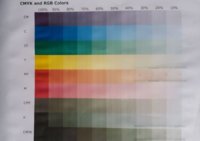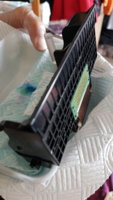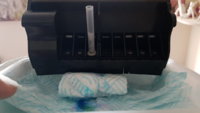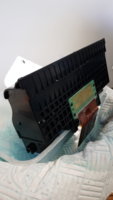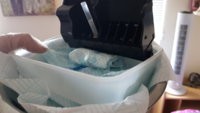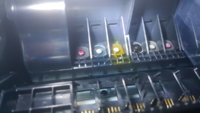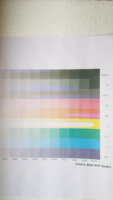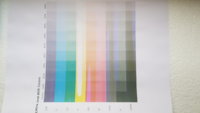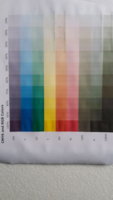Photographic Memory
Printing Ninja
- Joined
- Oct 31, 2017
- Messages
- 111
- Reaction score
- 41
- Points
- 83
- Printer Model
- Canon Pro 100S
Been having some serious issues with the Yellow clog during the past month or so. The amount of times I have taken out the Print Head and soaked it either overnight or for days. I was about to contact Canon or buy a new Print Head (when we bought the Pro-100 S we also added 2-year Protection on top of Canon warranty to cover '''Accidental Damage")
Here is what I have been experiencing:
Prints fine for a while, then Magenta cast - Yellow stops flowing.
Run a Nozzle Check. No Yellow.
Run a Clean. Yellow comes back. For a sheet or 2. Then block.
Take Print Head out. Now usual conconction of all Chemicals at my disposal (Windex-D, Isopropyl/Isopropanol, Ammonia, good old Dish Soap). *I'm surprised the Print Head hasn't disintegrated, really!!
This is where it gets really interesting ->
Rubber Tubing/Syringe to watch the blue Windex-D drip down -> here's the thing... It kind of did initially and then didn't. Just stayed in the tube.
HERE'S THE THING...
Unscrew the Nozzle [Ceramic] Plate *see attached photos*
I would try to use the Syringe and nothing would budge. Even seriously forceful (at
this point I was ready to destroy the P.H. as I had it in my mind I would either ask Canon to send me a new one or buy one so nothing to lose)
So at this point I figured all this soaking of the Nozzles was risking damaging them and after all it wasn't even at that end we had a problem, it was inside the plastic block. But what was blocking the Yellow channel so badly that even extreme physical force (syringe) wouldn't dislodge whatever was constantly in there.
Here's how I fixed it. And so far so good for the past few days, I didn't want to keep coming crying here with this problem. I know The Hat and others would have told me otherwise and certainly not advise what I am about to tell you. Ready?
Boiling hot water from the kettle and pure 'deadly to breathe' Ammonia alternating in the tubing for about 2-5 minutes. Ran this procedure for about 20 minutes having separated the delicate (yeah right, this thing is stronger than we think) ribbon cable-attached Nozzle section out of harms way - in fact not one drop of anything came close to the Nozzles doing this.
Hey. It worked! A try at the syringe just eased the ammonia/hot water out the other end and test of just plain water in the tubing went straight through in about a minute. Quicker than I have ever witnessed before.
My whole point of this post is, don't always presume the Nozzles are clogged. In this instance mine weren't. At all. It was the block all along.
Now whatever was causing this we may never know, but for now all is good. And seen as we are not tampering with the Electrical contacts, Silicone glue, Ribbon Cable, etc don't worry too much about using "deadly force".
This print head still has life in it. Granted it's only 8 months old, but it's taken a beating and been doused with every lethal chemical barring hydrocloric acid and toilet bleach (hmm, put those on my shopping list for next time?)
Thank for hearing my success story. Glad to be of assistance. Yep, that's a mixture of Ammonia and Boiling Hot Water alternating. For a few minutes each pass. Just separate the Nozzles. Enjoy!
Here is what I have been experiencing:
Prints fine for a while, then Magenta cast - Yellow stops flowing.
Run a Nozzle Check. No Yellow.
Run a Clean. Yellow comes back. For a sheet or 2. Then block.
Take Print Head out. Now usual conconction of all Chemicals at my disposal (Windex-D, Isopropyl/Isopropanol, Ammonia, good old Dish Soap). *I'm surprised the Print Head hasn't disintegrated, really!!
This is where it gets really interesting ->
Rubber Tubing/Syringe to watch the blue Windex-D drip down -> here's the thing... It kind of did initially and then didn't. Just stayed in the tube.
HERE'S THE THING...
Unscrew the Nozzle [Ceramic] Plate *see attached photos*
I would try to use the Syringe and nothing would budge. Even seriously forceful (at
this point I was ready to destroy the P.H. as I had it in my mind I would either ask Canon to send me a new one or buy one so nothing to lose)
So at this point I figured all this soaking of the Nozzles was risking damaging them and after all it wasn't even at that end we had a problem, it was inside the plastic block. But what was blocking the Yellow channel so badly that even extreme physical force (syringe) wouldn't dislodge whatever was constantly in there.
Here's how I fixed it. And so far so good for the past few days, I didn't want to keep coming crying here with this problem. I know The Hat and others would have told me otherwise and certainly not advise what I am about to tell you. Ready?
Boiling hot water from the kettle and pure 'deadly to breathe' Ammonia alternating in the tubing for about 2-5 minutes. Ran this procedure for about 20 minutes having separated the delicate (yeah right, this thing is stronger than we think) ribbon cable-attached Nozzle section out of harms way - in fact not one drop of anything came close to the Nozzles doing this.
Hey. It worked! A try at the syringe just eased the ammonia/hot water out the other end and test of just plain water in the tubing went straight through in about a minute. Quicker than I have ever witnessed before.
My whole point of this post is, don't always presume the Nozzles are clogged. In this instance mine weren't. At all. It was the block all along.
Now whatever was causing this we may never know, but for now all is good. And seen as we are not tampering with the Electrical contacts, Silicone glue, Ribbon Cable, etc don't worry too much about using "deadly force".
This print head still has life in it. Granted it's only 8 months old, but it's taken a beating and been doused with every lethal chemical barring hydrocloric acid and toilet bleach (hmm, put those on my shopping list for next time?)
Thank for hearing my success story. Glad to be of assistance. Yep, that's a mixture of Ammonia and Boiling Hot Water alternating. For a few minutes each pass. Just separate the Nozzles. Enjoy!


